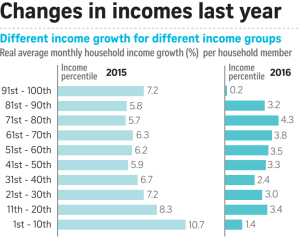William Baumol was a famous American Economist who passed away last year.
A hugely influential Economist of the 20th century, Baumol was a prolific writer and thinker whose best known works included the Theory of Contestable Markets, various theories of entrepreneurship and what came to be known as Baumol’s Cost Disease.
It is the latter that we will be exploring in greater detail today.
What is Baumol’s Cost Disease?
In the 1960s, Baumol observed something curious. He noticed that musicians displayed little or no increase in productivity through the years.
Specifically, playing a piece written for a string quartet took four musicians the same amount of time in 1965 as it did in 1865. And yet musicians in 1965 made a lot more money than musicians in 1865!
It turned out that as the American economy matured, the manufacturing sector had become more productive through the increase in capital inputs and technological advances.
In accordance to the neoclassical Economics theories, this increased output enabled higher revenue for firms which allowed for an increase in wages.
While that explanation worked for the manufacturing sector, it obviously could not have been the case for the musicians, as their productivity had not increased, and yet their wages had.
Baumol postulated that the increase in wages for the musicians came about because the increase in wages in the manufacturing sector had put pressure on the music industry to pay musicians higher wages to avoid musicians substituting their instruments for machines.
This increase in wages for sectors that had shown no corresponding increase in productivity came then to be known as Baumol’s Cost Disease.
Baumol’s Cost Disease spells T-R-O-U-B-L-E.
Increases in manufacturing productivity should bode well for us. After all, the cost per unit output falls and the benefits accrued to the firms can be shared with us through:
- Increase in workers’ wages, and
- Lower goods prices
Baumol’s Cost Disease can perhaps be avoided if all industries were capable of supporting increases to productivity. Unfortunately, this isn’t the case, especially in the services sector.
Take for example, doctors, lawyers and teachers. These professions can perhaps be “more productive” by serving more people per period of time.
However these professions tend to require a disproportionately large “human touch” factor that significantly restricts such efforts. At least for now, you are unlikely to see raving positive reviews citing “uncaring and disengaged” doctors or teachers!
As a result of wages increasing without corresponding increases in productivity, these industries will tend to become more expensive over time.
Crucially, it is no coincidence that these “human-touch”-heavy sectors are often essential services for most of us. What this means is that:
- We are unable to avoid these increases in costs.
- These costs tend to form a large part of our expenses which amplifies their impacts on us.
Baumol’s Cost Disease on healthcare costs in Singapore.
One of the hottest “coffee-shop” talk these days involves rising healthcare costs in Singapore.
Unofficially at least, the average Singaporean household was estimated to spend at least 8-10% of the income on health and personal care. This is a significant expenditure item and any increase in price will be felt keenly.
As many of us are aware, healthcare costs have increased significantly. In fact, it was reported recently that Singapore’s healthcare costs are expected to be the 4th fastest regionally in price escalation.
But this should be no surprise, going by the earlier discourse on Baumol’s Cost Disease.
Back in 2013, Donald Low, then Senior Fellow and Assistant Dean (Research Centres) at the Lee Kuan Yew School of Public Policy, wrote an article that discussed on this very topic. This was an excellent piece and the subsequent analysis was derived from his insights.
Singapore’s healthcare: Not all is doomed, but more needs to be done?
For reasons earlier discussed in this article, Baumol’s Cost Disease can be expected to manifest strongly in the healthcare sector of Singapore, particularly as we attempt to wean ourselves off imported labour.
This is therefore an exercise of coping with the inevitable.
Baumol noted that the best long-term solution would be for sustained economic growth that is productivity-driven. The idea is to ensure that income growth levels outpace inflation rates, enabling the consumer’s purchasing power to stay uneroded.
Where the growth in income occurs is important however. If the growth is accrued to only a few, most of us will not experience this growth in income and erosion of purchasing power over time will occur.
In particular, there have been growing concerns about the lower income groups whose salaries have remained stagnant over the years.
In 2017, it was reported by the Straits Times that wage growth was the lowest for the low-income group in 2016 (0.2%). And while 2015 saw the income for this group increase by the largest proportion (10.7%), it would seem that this was a blip rather than the norm.
Interestingly, Low disagreed with the Singapore government’s approach of “individual responsibility” when it came to paying for treatment. In his view, this was misguided as it doesn’t solve the root issues underlying Baumol’s Cost Disease (not that we could have avoided it as noted earlier).
In fact, since healthcare is an indispensable part of our lives, attempting to instill “cost discipline” on patients in the hope of reducing demand on healthcare (and price therefore), will only serve to:
- Increase the cost burden on households further.
- Discourage timely health treatment when actually necessary.
In his view, understanding Baumol’s Cost Disease is key to implementing the most appropriate policies for Singapore’s healthcare sector.
So what are your thoughts about healthcare costs in Singapore?
Lend your support!
I hope that you have enjoyed reading this article of mine. I am giving my time to sharing my knowledge and every bit of support means a lot to me! Do drop me a comment or share this article on social media with your friends.
To find out more about my services as a JC Economics tutor, visit my website here.










Excellent site you have here but I was curious if you knew of any message boards that cover the same topics talked about in this article? I’d really love to be a part of online community where I can get advice from other knowledgeable people that share the same interest. If you have any suggestions, please let me know. Bless you!
LikeLike
I’ve read some excellent stuff here. Definitely value bookmarking for revisiting.
I surprise how so much attempt you place to make this kind of fantastic
informative website.
LikeLike